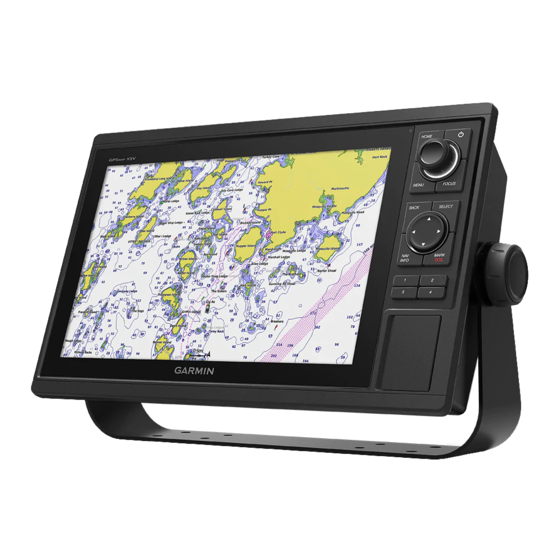Garmin AQUAMAP 10x2 Series Kurulum Talimatları Kılavuzu - Sayfa 3
GPS Garmin AQUAMAP 10x2 Series için çevrimiçi göz atın veya pdf Kurulum Talimatları Kılavuzu indirin. Garmin AQUAMAP 10x2 Series 8 sayfaları.
Ayrıca Garmin AQUAMAP 10x2 Series için: Kurulum Talimatları Kılavuzu (10 sayfalar)

4
Install the bail-mount knobs
on the sides of the device.
5
Place the device in the bail-mount bracket and tighten the bail-mount
knobs.
Flush Mounting the Device
NOTICE
Be careful when cutting the hole to flush mount the device. There is only a
small amount of clearance between the case and the mounting holes, and
cutting the hole too large could compromise the stability of the device after it is
mounted.
The included template and hardware can be used to flush mount the device in
your dashboard.
1
Trim the template, and make sure it fits in the location where you want to
mount the device.
2
Secure the template to the mounting location.
3
9
Using a 14 mm (
/
in.) drill bit, drill one or more of the holes inside the
16
corners of the solid line on the template to prepare the mounting surface
for cutting.
4
Using a jigsaw or a rotary tool, cut the mounting surface along the inside
line on the template.
5
Place the device in the cutout to test the fit.
6
If necessary, use a file and sandpaper to refine the size of the cutout.
7
Use a pry tool, such as a flat piece of plastic or a screwdriver, to carefully
pry up the corners of the trim caps, slide the pry tool to the center, and
remove the trim caps.
NOTICE
Use a plastic pry tool when possible. Using a metal pry tool such as a
screwdriver can damage the trim caps and the device.
8
After the device fits correctly in the cutout, ensure the mounting holes on
the device line up with the larger 6 mm (
9
If the mounting holes on the device do not line up, mark the new hole
locations.
10
Select an option:
• If you are using a nut plate, drill a 6 mm (
location.
• If you are not using a nut plate, drill 3.2 mm (
hole locations.
11
Starting in one corner of the template, place a nut plate
hole
drilled in the previous step.
If you are using a nut plate, the smaller hole
up with the smaller hole on the template.
12
If the smaller hole on the nut plate does not line up with the smaller hole on
the template, mark the new hole location.
13
If you are using a nut plate, drill a 3.6 mm (
location.
14
Repeat to verify placement of the remaining nut plates and holes on the
template.
15
Remove the template from the mounting surface.
16
Starting in one corner of the mounting location, place a nut plate
back of the mounting surface, lining up the large and small holes.
The raised portion of the nut plate should fit into the larger hole.
2
1
/
in.) holes on the template.
4
1
/
in.) hole in the larger hole
4
1
/
in.) holes in the larger
8
over the larger
on the nut plate should line
9
/
in.) hole in the smaller hole
64
on the
17
Secure the nut plates to the mounting surface by fastening the included M3
screws
through the smaller 3.6 mm (
18
Install the foam gasket
on the back of the device.
The pieces of the foam gasket have adhesive on the back. Make sure you
remove the protective liner before installing them on the device.
19
If you will not have access to the back of the device after you mount it,
connect all necessary cables to the device before placing it into the cutout.
NOTICE
To prevent corrosion of the metal contacts, cover unused connectors with
the attached weather caps.
20
Apply marine sealant between the mounting surface and the device to
properly seal and prevent leakage behind the dashboard.
21
If you will have access to the back of the device, apply marine sealant
around the cutout.
22
Place the device into the cutout.
23
Secure the device to the mounting surface using the included M4 screws
.
24
Wipe away all excess marine sealant.
25
Install the trim caps by snapping them in place around the edges of the
device.
Connection Considerations
After connecting the cables to the device, tighten the locking rings to secure
each cable.
Power/NMEA
®
0183 Cable
• The wiring harness connects the device to power, NMEA 0183 devices,
and a lamp or a horn for visible or audible alerts.
• If it is necessary to extend the NMEA 0183 or alarm wires, you must use
22 AWG (.33 mm²) wire.
• This cable provides one differential NMEA 0183 input and output port.
Item
Wire Color
Wire Function
Red
Power
Black
Ground (power and NMEA 0183)
Blue
NMEA 0183 TxA (Out +)
Gray
NMEA 0183 TxB (Out -)
Brown
NMEA 0183 RxA (In +)
9
/
in.) holes.
64
